Unité de Catalyse et de Chimie du Solide site Artois
Faculté des Sciences de Lens
PUBLICATIONS MARQUANTES 2018 :
- 8 publications [à Facteur d'impact > 5]
- «An ambient-temperature aqueous synthesis of zirconium-based metal-organic frameworks»
I. Pakamorė, J. Rousseau, C. Rousseau, E. Monflier, P. Ágota Szilágyi
Green Chem., 2018, 20, 5292-5298 - doi: 10.1039/c8gc02312c
IF =9,405
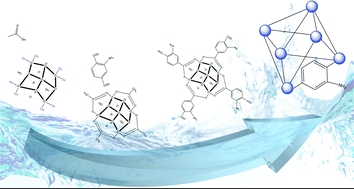 |
| For the first time, we have developed an aqueous ambient-temperature synthesis of the zirconium-based metal–organic framework NH2-UiO-66. The optimised synthetic route offers greatly reduced energy input compared with the conventional solvothermal synthetic method and it does not require any organic solvents or vapours. This facile process is easily up-scalable and it yields highly porous nanoparticles. Samples that underwent the reaction in a shorter amount of time displayed point defects of the dangling linker type. |

- «Cyclodextrin-assisted low-metal Ni-Pd/Al2O3 bimetallic catalysts for the direct amination of aliphatic alcohols»
A. Tomer, B. T. Kusema, J-F. Paul, C. Przybylski, E. Monflier, M. Pera-Titus, A. Ponchel
J Catal 2018, 368, 172-189 - doi: 10.1016/j.jcat.2018.10.002
IF = 7,723
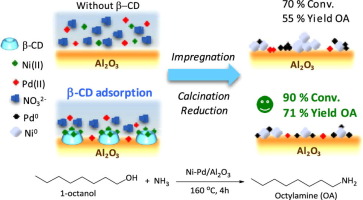 |
| This paper reports the use of β-cyclodextrin as a pre-shaping agent for the preparation of low-metal xNi-yPd/Al2O3 catalysts (x = 2, 5 wt% and y = 0.2, 0.5, 1.0 wt%) targeting the direct amination of 1-octanol with ammonia. Six different preparation methods were used aiming at tuning the Ni-Pd interaction. The catalysts were finely characterized by XRD, H2-TPR, CO pulse chemisorption, STEM-EELS/EDS-SDD and XPS, while the elementary interaction between Ni-Pd-cyclodextrin was assessed by marrying ESI-MS experiments with DFT calculations. Among the different methods studied, the most outstanding effect was obtained when β-cyclodextrin was pre-adsorbed on γ-Al2O3 before impregnating the Ni and Pd nitrate precursors. At such conditions, the best formulation (5Ni-0.5Pd/Al-CD_M4) afforded 90% conversion and 71% yield to 1-octylamine (TON = 93) in the amination of 1-octanol with ammonia at 160 °C for 4 h, which places it among the most active and selective Ni catalysts reported in the literature. |

- «Hydrogen storage in MgX (X=Cu and Ni) systems - is there still news»
G. Lefevre, S. Saitzek, R. Desfeux, N. Kunkel, A. Sayede
Journal of Power Sources 402 (2018) 394-401 - doi: 10.1016/j.jpowsour.2018.09.043
IF = 7,467
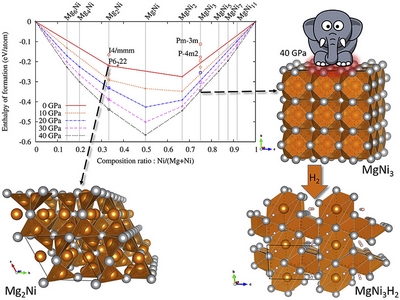 |
| Among lightweight materials, magnesium-containing systems are of interest for hydrogen storage. Here, we use an efficient prediction scheme at ab initio level in order to identify new magnesium-based alloys that are stable under elevated pressure. The calculations show that pressure can radically change the minimum energy compositions and various new Mg-rich compounds were found under these conditions. For these Mg-rich compounds, a careful investigation and a search for potential hydrides was carried out and our study on the electronic properties reveals interesting information on the behavior of hydrogen atoms. Our theoretical investigations are in good agreement with very recent experimental results and demonstrate a possibility to identify destabilized metal hydrides. Consequently, the present result encourages the use of similar prediction schemes in order to identify and design destabilized systems for hydrogen storage applications. |

- «Quenching of Spin Polarization Switching in Organic Multiferroic Tunnel Junctions by Ferroelectric “Ailing-Channel” in Organic Barrier»
S. Liang, Z. Yu, X. Devaux, A. Ferri, W. Huang, H. Yang, R. Desfeux, X. Li, S. Migot, D. Chaudhuri, H. Yang, M. Chshiev, C. Yang, B. Zhou, J. Fang, S. Mangin, and Y. Lu
ACS Appl. Mater. Interfaces 2018, 10 (36), pp 30614–30622 - doi: 10.1021/acsami.8b11437
IF = 8,456
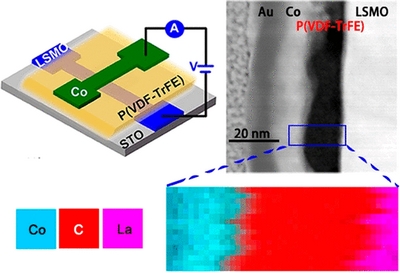 |
| The ferroelectric control of spin-polarization at ferromagnet (FM)/ferroelectric organic (FE-Org) interface by electrically switching the ferroelectric polarization of the FE-Org has been recently realized in the organic multiferroic tunnel junctions (OMFTJs) and gained intensive interests for future multifunctional organic spintronic applications. Here, we report the evidence of ferroelectric “ailing-channel” in the organic barrier, which can effectively pin the ferroelectric domain, resulting in nonswitchable spin polarization at the FM/FE-Org interface. In particular, OMFTJs based on La0.6Sr0.4MnO3/P(VDF-TrFE) (t)/Co/Au structures with different P(VDF-TrFE) thickness (t) were fabricated. The combined advanced electron microscopy and spectroscopy studies clearly reveal that very limited Co diffusion exists in the P(VDF-TrFE) organic barrier when the Au/Co electrode is deposited around 80K. Pot-hole structures at the boundary between the P(VDF-TrFE) needle-like grains are evidenced to induce “ailing-channels” that hinder efficient ferroelectric polarization of the organic barrier and result in the quenching of the spin polarization switching at Co/P(VDF-TrFE) interface. Furthermore, the spin diffusion length in the negatively polarized P(VDF-TrFE) is measured to be about 7.2 nm at 20K. The evidence of the mechanism of ferroelectric “ailing-channels” is of essential importance to improve the performance of OMFTJ and master the key condition for an efficient ferroelectric control of the spin polarization of “spinterface”. |

- «Amines as Effective Ligands in Iridium-Catalyzed Decarbonylative Dehydration of Biosourced Substrates»
J. Ternel, B. Léger, E. Monflier, F. Hapiot
Catal. Sci. Technol. 2018, 8, 3948-3953 - doi: 10.1039/C8CY00621K
IF = 5,726
 |
| Linear α-olefins (LAO) and linear internal olefins (LIO) are essential intermediates in the synthesis of surfactants, lubricants, and polymers. Concurrently to petroleum-based industrial processes, the production of LAO and LIO from renewable feedstocks has gained increasing interest in recent years. Organometallic catalysts have been developed designedly, especially Pd, Fe and Ir catalysts. However, such catalysts are mostly stabilized by phosphanes, ligands sometimes difficult to handle especially on large scales. Alternative to phosphanes would thus be highly desirable. In the present study, we demonstrate that Ir catalysts coordinated by amines are suitable to decarbonylate a wide range of biosourced substrates under mild conditions. The resulting LAO and LIO are obtained with good conversion provided that the nature and the quantity of the amine are controlled accurately. The LAO/LIO selectivity can also be tuned by a judicious choice of the experimental conditions. Interestingly, the Ir-based catalytic system is applicable to the decarbonylative dehydration of satured, unsaturated and polyunsatured fatty acids. |

- «Nanoscale Investigations of α- and γ-Crystal Phases in PVDF-Based Nanocomposites»
S. Barrau , A. Ferri, A. Da Costa, J. Defebvin, S. Leroy, R. Desfeux, J-M. Lefebvre
ACS Appl. Mater. Interfaces 2018, Vol. 10, Issue 15, pp. 13092-13099
doi: 10.1021/acsami.8b02172
IF = 8,456
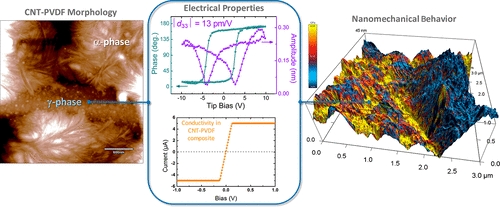 |
| The impact of carbon nanotube (CNT) incorporation into semicrystalline poly(vinylidene fluoride), PVDF, was investigated at both the macro and nanoscales. A special effort was devoted to probe the local morphology and the mechanical, ferroelectric, piezoelectric, and electrical conductivity response by means of atomic force microscopy. Incorporation of CNTs mainly induces the development of the polar γ-phase, and as a consequence, the coexistence of the γ-phase with the most stable nonpolar α-phase is observed. A maximum γ-phase content is reached at 0.7 wt % CNT loading. The spherulitic morphology of the PVDF α-phase is assessed, in conjunction with the lack of any ferroelectric response, while the presence of the polar γ-phase is confirmed, owing to clear piezoresponse signals. Local piezoelectric measurements on γ-phase domains yield a maximum effective coefficient |d33| ≈ 13 pm/V, thus underlining the potential for applications of such functional PVDF-based nanocomposites in advanced piezoelectric devices. An increase in macroscopic conductivity with CNT content is observed, with a percolation threshold achieved for a composition close to 0.7 wt %. Nanoscale investigation of the electrical conductivity confirms the presence of some infinite CNT cluster homogeneously distributed over the surface. The macroscopic viscoelastic behavior of the composite reflects the reinforcing effect of CNTs, while the nanomechanical characterization yields a local contact modulus of the γ-phase domains larger than that of its α-phase counterpart, in agreement with the fact that the CNTs act as γ-phase promoters and subsequently reinforce the γ-domains. |

- «Robust Mesoporous CoMo/γ-Al2O3 Catalysts from Cyclodextrin-Based Supramolecular Assemblies for Hydrothermal Processing of Microalgae: Effect of the Preparation Method»
R. Bleta, B. Schiavo, N. Corsaro, P. Costa, A. Giaconia, L. Interrante, E. Monflier, G. Pipitone, A. Ponchel, S. Sau, O. Scialdone, S. Tilloy, A. Galia
ACS Appl. Mater. Interfaces 2018,10(15), 12562-12579 - doi: 10.1021/acsami.7b16185
IF = 8,456
 |
| Hydrothermal liquefaction (HTL) is a promising technology for the production of biocrude oil from microalgae. Although this catalyst-free technology is efficient under high-temperature and high-pressure conditions, the biocrude yield and quality can be further improved by using heterogeneous catalysts. The design of robust catalysts that preserve their performance under hydrothermal conditions will be therefore very important in the development of biorefinery technologies. In this work, we describe two different synthetic routes (i.e., impregnation and cyclodextrin-assisted one-pot colloidal approach), for the preparation in aqueous phase of six high surface area CoMo/γ-Al2O3 catalysts. Catalytic tests performed on the HTL of Nannochloropsis gaditana microalga indicate that solids prepared by the one-pot colloidal approach show higher hydrothermal stability and enhanced biocrude yield with respect to the catalyst-free test. The positive effect of the substitution of the block copolymer Tetronic T90R4 for Pluronic F127 in the preparation procedure was evidenced by diffuse reflectance UV–visible spectroscopy, X-ray diffraction, N2-adsorption–desorption, and H2-temperature-programmed reduction measurements and confirmed by the higher quality of the obtained biocrude, which exhibited lower oxygen content and higher-energy recovery equal to 62.5% of the initial biomass. |

- «Unconventional media and technologies for starch etherification and esterification»
A. Gilet, C. Quettier, V. Wiatz, H. Bricout, M. Ferreira, C. Rousseau, E. Monflier and S. Tilloy
Green Chem., 2018, 20, 1152–1168 - doi: 10.1039/C7GC03135A
IF =9,405
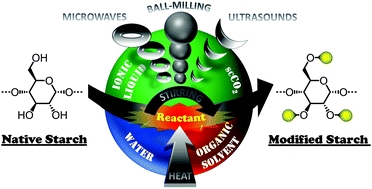 |
| Among the most widespread starch derivatives, etherified and esterified starches play an important role. These derivatives are generally prepared by using thermal energy and conventional solvents. This review summarizes the recent advancements in etherification and esterification of starch in unconventional media, i.e. ionic liquids or supercritical CO2, and by employing unconventional technologies, i.e. microwaves, ultrasounds or ball-milling. The present contribution aims to provide an overview to help researchers seeking an alternative medium or technology to functionalize starch. The green aspects of unconventional approaches were presented and physical-chemical properties of modified starches obtained by these approaches were also described. Whenever possible, the advantages and disadvantages of each system are discussed. Finally, even if it is not always mentioned in the publications, the use of these experimental conditions probably lead to a partial degradation of starch molecular structure. |

Faculté Jean Perrin - rue Jean Souvraz - SP 18 - 62307 Lens Cedex
tel : 03 21 79 17 05
fax : 03 21 79 17 55 |






